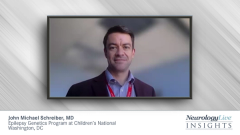
Opinion|Videos|October 31, 2024
Epilepsy in Pediatric Population: Prevalence, Pathophysiology, and Disease Heterogeneity
Author(s)John Michael Schreiber, MD
Key Takeaways
- Pediatric epilepsy affects 0.5-1% of children, with increased prevalence in those with developmental disabilities.
- Abnormal electrical brain activity, genetic mutations, structural abnormalities, and metabolic disorders contribute to epilepsy pathophysiology.
John Michael Schreiber, MD, provides an overview of epilepsy in infant and pediatric patients, including its prevalence, and describes the pathophysiology of infantile and pediatric epilepsy, highlighting how the disease’s heterogeneity affects diagnosis.
Advertisement
Episodes in this series

Now Playing
- Please provide an overview of epilepsy in infant and pediatric patients.
- What is the prevalence of epilepsy in pediatric patients?
- Please describe the pathophysiology of infantile and pediatric epilepsy.
- How does the heterogeneity of the disease affect diagnosis?
Newsletter
Keep your finger on the pulse of neurology—subscribe to NeurologyLive for expert interviews, new data, and breakthrough treatment updates.
Advertisement
Latest CME
Advertisement
Advertisement
Trending on NeurologyLive - Clinical Neurology News and Neurology Expert Insights
1
NeurologyLive® Year in Review 2025: Top Podcast Episodes
2
Remyelinating Agent PIPE-307 Falls Short in Phase 2 Trial of Relapsing Multiple Sclerosis
3
Episode 157: Clinical Advances and Unanswered Questions in Narcolepsy
4
NeurologyLive® Friday 5 — December 26, 2025
5























